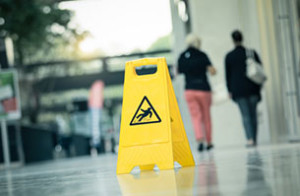Slip and Fall Injuries
Every year, millions of people visit hospital emergency rooms as the result of slip and fall accidents. Thousands are hospitalized and some are seriously injured or even killed in slip-and-fall accidents. However, not every slip-and-fall accident results in a personal injury claim. These cases, which may appear simple, can actually be very complicated, especially when it comes to proving fault. How can a victim prove that another party is at fault for a slip-and-fall injury?
Quick Reference Links
- The Realities of Slip-and-Fall Cases
- The Difference Between Fault and Accident
- How To Tell If The Owner Is Negligent
- How To Get Help With Your Case
The Realities of Slip-and-Fall Cases
 Slip-and-fall accidents can happen almost anywhere. There are actually several subcategories of slip-and-fall accidents, including trips, which occur when the foot strikes an obstacle and causes the victim to fall; slips, in which the foot slips on a surface and causes the victim to lose balance; and falls, which can occur on the same level or from one level to another.
Slip-and-fall accidents can happen almost anywhere. There are actually several subcategories of slip-and-fall accidents, including trips, which occur when the foot strikes an obstacle and causes the victim to fall; slips, in which the foot slips on a surface and causes the victim to lose balance; and falls, which can occur on the same level or from one level to another.
Generally speaking, property owners are required to keep their premises safe for visitors. This means cleaning up potential tripping hazards, keeping floors and sidewalks free of slippery ice or water and ensuring that stairs and corridors are well-lighted and free of obstacles that can lead to a fall. However, just because a slipping or tripping hazard occurs on a property does not automatically mean that the owner is responsible.
The Difference Between Fault and Accident
The law recognizes that true accidents can and do happen. In the normal course of life, victims sometimes slip or fall not due to anyone's negligence but through their own inattention or due to circumstances beyond anyone's control. In these cases, the victim may not be able to support a claim against the property owner for negligence.
However, there are cases in which it is clear that the property owner knew or should have known that there was a slip-and-fall risk to visitors. In general, the test for liability focuses on a simple question: did the property owner take all necessary steps to alleviate any tripping or slipping hazards? If the answer is no, the property owner might be liable for the victim's injuries.
How To Tell If The Owner Is Negligent
In order to show negligence on the part of the property owner, it is usually sufficient to show one of three things: the owner caused the spill, obstacle or other tripping hazard; the owner knew of the dangerous surface but did nothing to alleviate the problem; or the owner should reasonably have known about the situation through the exercise of normal caution.
 It is not always easy to prove that an owner "should have known" about a dangerous situation. In most cases, victims can benefit from the help of an experienced personal injury attorney. An attorney will attempt to collect evidence that points to the property owner's knowledge of the hazard or show that the owner should have known that the situation was dangerous. In addition, an attorney will also attempt to mitigate any fault on the part of the victim such as running instead of walking or entering a prohibited area.
It is not always easy to prove that an owner "should have known" about a dangerous situation. In most cases, victims can benefit from the help of an experienced personal injury attorney. An attorney will attempt to collect evidence that points to the property owner's knowledge of the hazard or show that the owner should have known that the situation was dangerous. In addition, an attorney will also attempt to mitigate any fault on the part of the victim such as running instead of walking or entering a prohibited area.
How To Get Help With Your Case
If you are a victim of a slip and fall accident and are not sure where to turn, contact a premises liability attorney at David Law Group, P.A. today. We will discuss your case with you and if necessary, help gather the evidence needed to prove an injury claim.

